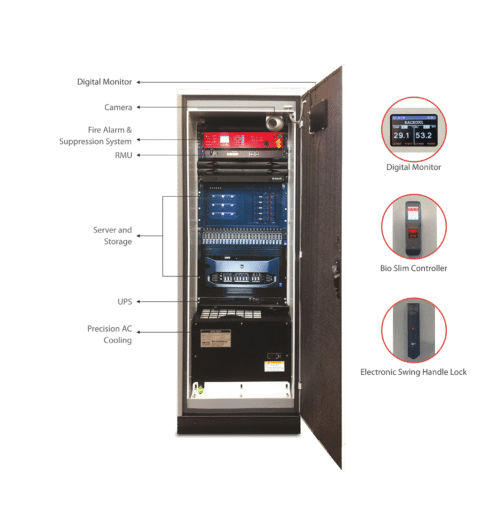Mitigating EMI/RFI Interference in Rack Enclosures for Defense and Aerospace Applications
Comments Off on Mitigating EMI/RFI Interference in Rack Enclosures for Defense and Aerospace ApplicationsElectromagnetic interference (EMI) and radio-frequency interference (RFI) pose critical challenges in defense and aerospace applications. Mission-critical electronics must operate reliably in high-noise environments, where even minor disruptions can compromise system performance and safety. Engineers working with rack enclosures must implement robust shielding, grounding, and filtering strategies to mitigate interference and ensure compliance with MIL-STD-461, DO-160, and other stringent standards. This article explores best practices for reducing EMI/RFI in rack-mounted systems.
1. Shielding Strategies for Rack Enclosures
Effective EMI shielding begins with the enclosure itself, as inadequate shielding can lead to excessive radiated emissions and system malfunctions. Selecting the right materials and design features can significantly reduce interference:
- Conductive Materials: Enclosures made of aluminum, specifically Aluminum 6061-T6 and Alloy 6063-T5, provide effective attenuation of EMI due to their excellent electrical conductivity and lightweight properties. These alloys offer high shielding effectiveness by reflecting and absorbing electromagnetic waves, preventing emissions from escaping or external interference from penetrating the enclosure. Additionally, their natural oxide layer provides corrosion resistance, ensuring long-term reliability in demanding aerospace and defense environments.
- Conductive Gaskets and Seals: EMI-shielded enclosures should include conductive elastomer gaskets at panel joints, doors, and access points to prevent leakage.
- Honeycomb Vent Panels: Shielded ventilation panels maintain airflow while blocking high-frequency emissions. These panels are available in various cell sizes and angles, such as 30-degree and 45-degree configurations, to optimize shielding effectiveness while ensuring adequate ventilation. The choice of angle impacts both airflow resistance and attenuation, allowing engineers to balance thermal management with EMI mitigation.
- Transparent EMI-Shielded Windows: When displays or observation ports are required, laminated conductive films or fine-mesh shielding can be used to maintain protection.
2. Grounding and Bonding Techniques
A well-designed grounding and bonding strategy minimizes unwanted signal coupling and ensures enclosure effectiveness by providing a controlled path for electrical currents to dissipate safely. Properly implemented grounding techniques help stabilize voltage levels, reduce differential-mode interference, and enhance overall electromagnetic compatibility (EMC) within the enclosure.
- Single-Point Grounding: Establishing a single, well-defined ground reference prevents circulating ground loops that can exacerbate EMI.
- Low-Impedance Connections: Using braided ground straps and minimizing ground path resistance reduces differential mode noise.
- Chassis Bonding: Ensuring all components, including doors and panels, maintain a continuous conductive path prevents unintended radiated emissions.
3. Cable and Connector Management
Poorly routed cables and improper connector selection can introduce significant EMI/RFI issues. For example, running unshielded signal cables in close proximity to high-power lines can induce unwanted noise, leading to degraded signal integrity or even system malfunctions. Similarly, using non-filtered connectors in high-frequency environments can allow electromagnetic interference to propagate, affecting overall system performance.
- Shielded Cables: Using twisted-pair shielded cables for power and signal lines helps mitigate conducted emissions.
- Filtered Connectors: EMI-filtered connectors, such as MIL-DTL-38999 or custom multi-pin solutions, integrate capacitive and ferrite filtering to suppress high-frequency noise.
- Proper Cable Routing: Maintaining separation between power and signal lines, avoiding loops, and securing cables with conductive clamps can reduce unwanted emissions.
4. Noise Suppression
Noise suppression within the rack is critical to maintaining system integrity and minimizing interference between components. Implementing the following strategies can significantly enhance noise mitigation:
- Conductive Rack Coatings: Using conductive paint or plating on rack interiors helps reduce radiated emissions by providing additional shielding.
- Damping Materials: Applying EMI-absorbing foam or ferrite-loaded materials within enclosures can suppress high-frequency emissions inside the rack.
- Vibration Isolation Mounts: Mechanical vibrations can generate microphonic noise that affects sensitive electronics; using isolation mounts can help mitigate this issue.
- Rack Grounding Techniques: Ensuring racks are properly bonded to facility ground reduces stray currents and minimizes EMI coupling between mounted equipment.
5. Compliance Testing and Validation
Ensuring rack enclosures meet stringent EMI/RFI requirements necessitates thorough testing and validation. MIL-STD-461 defines the electromagnetic compatibility (EMC) requirements for military equipment, covering conducted and radiated emissions as well as susceptibility. It includes specific test procedures such as conducted emissions (CE), radiated emissions (RE), conducted susceptibility (CS), and radiated susceptibility (RS) to ensure electronic systems can operate without interference.
A common failure occurs when enclosures do not provide adequate shielding at panel seams, resulting in radiated emissions exceeding MIL-STD-461 limits. Another frequent issue is improper grounding of the enclosure, which can create ground loops that introduce unwanted noise and degrade system performance. Additionally, inadequate cable shielding and termination can allow high-frequency emissions to escape, causing interference with nearby systems.
These failures can lead to system malfunctions in mission-critical environments and signal degradation, requiring costly redesigns and retesting to achieve compliance.
Conclusion
EMI/RFI mitigation in defense and aerospace rack enclosures requires a multifaceted approach, integrating shielding, grounding, cable management, power filtering, and rigorous compliance testing. By implementing these best practices—such as selecting proper shielding materials, ensuring effective grounding, managing cables and connectors, filtering power lines, and adhering to MIL-STD-461 compliance—engineers can enhance the resilience of mission-critical systems. These measures help ensure robust operation in the harshest electromagnetic environments, reducing the risk of interference-related failures.
For those designing next-generation enclosures, considering EMI mitigation early in the design process reduces costly redesigns and certification failures. Are there specific EMI challenges you’ve encountered in rack enclosures? Share your insights in the comments below.
The mission doesn’t stop—and neither should your insight.
Subscribe to Rack and Ready for monthly strategies on enclosure design, MIL-STD compliance, cooling, and integration in defense systems.

 Conductive gaskets to create tight electrical seals on doors and access panels
Conductive gaskets to create tight electrical seals on doors and access panels